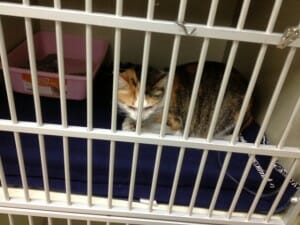
Yesterday, I breathed a deep sigh of relief. Yet, something inside told me that I couldn’t remain silent. Although my blogs never focus on animals, I am compelled to write about toxins and pets, more specifically cats and the deadly lily.
Deadly lily? Can a beautiful flower poison your cat? Yes!
A few days before Christmas, one of my good friends dropped off a lovely plant in honor of my newly released book, MAY THIS BE THE BEST YEAR OF YOUR LIFE. I was taken aback by her kind gesture. I watered the plant and proudly displayed my gift near a window. In a subsequent phone call, she casually mentioned that I should read about lilies since it appeared they might be poisonous to cats.
Without hesitation, my husband placed the plant in a spot beyond Chloe’s reach. The next day, we left for the mountains. The plant was moved closer to the window while we were away.
After returning from the mountains, the plant remained in a spot that was reachable to a curious cat. I had forgotten about the warning. My focus remained on writing blogs, engaging in social media, and organizing a marketing campaign. I never took time to make a simple Google search- Lilies and cats.
The day after returning from the mountains, I ran some errands. Within minutes of arriving home, I spotted Chloe nibbling on the flowering plant.
“Oh my God.” I exclaimed.
Immediately, I called the Broadway Animal Hospital in Boulder. I needed to bring Chloe in as soon as possible. Without a moment’s delay, I tried unsuccessfully to grab her. She instinctively hid under our king sized bed.
It seemed like hours before she pranced out of her hiding place. My persistent rescue attempts left me breathless and frustrated. Like many calico cats, Chloe was intent on having it her way. She ran whenever I got within a few feet. My efforts appeared fruitless until I lunged as she bolted up the staircase.
Once at the animal hospital, Chloe was immediately given a medicine that induced vomiting. She was locked in a cage where she regurgitated numerous times. Then IV fluids were administered. As I stood helplessly in disbelief, Dr. Kalenzi pulled out a medical textbook. The words in the book confirmed my worse fears. Chloe could die.
Each cat’s tolerance to poison is dependent on many factors. However, the main fact remained, lily flowers, stems, leaves, and pollen are deadly. Time was of the essence. The damage could begin as soon as the toxins entered her blood system. Kidney failure was the end result if the treatment was started too late. Just a few hours could mean the difference between life and death. I had no way of knowing how long Chloe had been chewing on the leaves or whether she had licked any pollen off of her fur.
Chloe had become part of our family ever since our son, Aaron, adopted her from the Humane Society of Boulder Valley during college. However, it was not until Aaron relocated to California that we began to bond with his pet. As empty nesters, she has become an integral part of our daily life. The thought of losing her made me extremely sad.

At the end of the day, we transported Chloe to Boulder Emergency Pet Clinic. This facility is open whenever veterinarian offices are closed- nights, weekends, and holidays. Chloe needed round-the-clock care and periodic blood tests. Once again, she was locked in a very small cage with just a litter box, food, and water. For over 48 hours, we transported her back and forth between the two facilities. She received compassionate care at both places.
Fortunately, the slightly elevated blood counts returned to normal and we now have Chloe back home. My total ignorance has motivated me to write this blog. I learned an important lesson. If I am going to be a responsible cat owner, I needed to be more knowledgeable. I urge other pet owners to know about potential hazards.
There are many wonderful websites that provide excellent information. One in particular, ASPCA (American Society for the Prevention of Cruelty to Animals) provides a comprehensive list of toxic plants and household items as well as useful information.
In 2013, 3 safeguards need to be instituted:
- Facilities or individuals selling pets should be obligated to provide a list of potential toxins.
- Animal Hospitals and veterinarian offices should have poison control pamphlets and periodically talk about toxins.
- Stores selling plants and flowers should have a posted sign that states, “Plants can be deadly to pets” and ask if the recipient has any pets.
As the year draws to a close, I wish everyone a wonderful and safe 2013.
Related Blogs:
Cats in the Mirror Series Review (Book Review- chapter book)
Tikvah Means Hope- Charming Classic for Sukkot (Book Review- picture book)
Sandra’s Bio:
Sandra Bornstein is the author of MAY THIS BE THE BEST YEAR OF YOUR LIFE. It is available on Amazon. Sandra’s memoir highlights her living and teaching adventure in Bangalore, India. She is a licensed Colorado teacher who has taught K-12 students in the United States and abroad as well as college level courses. Sandra is married and has four adult sons. The memoir was a finalist in the Travel category for the 2013 Next Generation Indie Book Awards, the 2013 International Book Awards, the 2013 National Indie Book Excellence Awards, the 2013 USA Best Book Awards, and received an Honorable Mention award in the Multicultural Non-Fiction category for the 2013 Global ebook Awards.
THANK YOU! I have had cats for many decades and never knew this. Disregard the jerks at the ABA.
Carroll, Yes, lilies can be deadly. It’s truly a shame that stores selling plants do not take this issue more seriously. The feedback on the ABA site certainly illustrates why more people aren’t interested in this problem. Hopefully, you’ll spread the word among your cat owner friends.